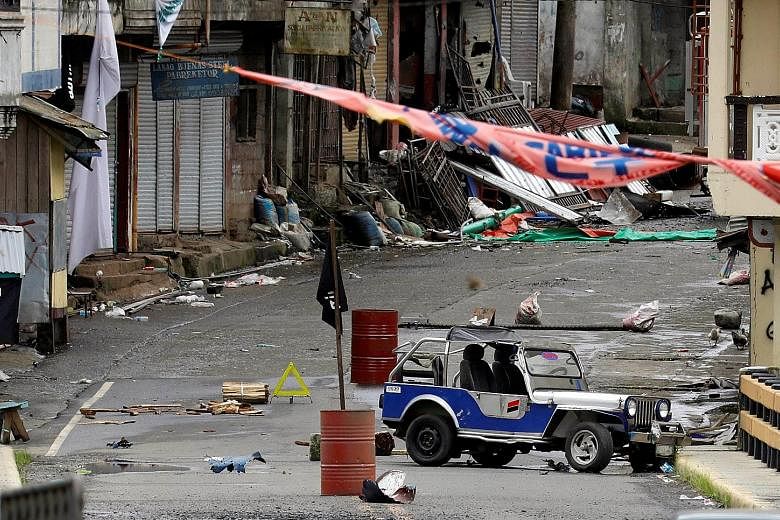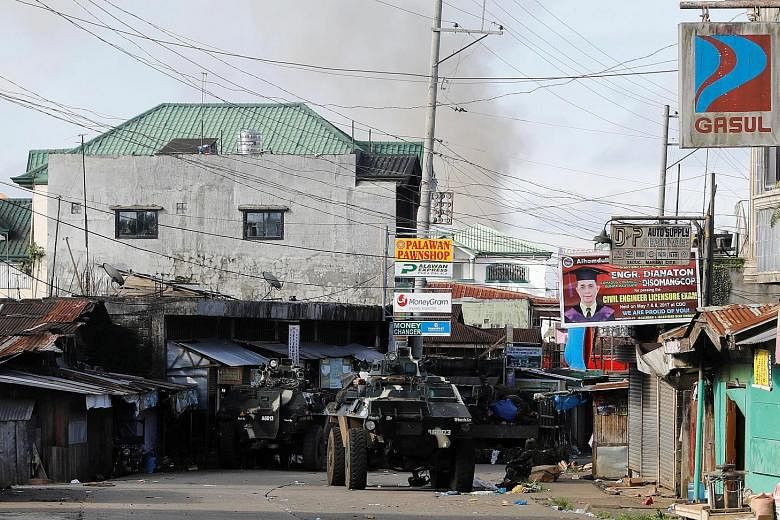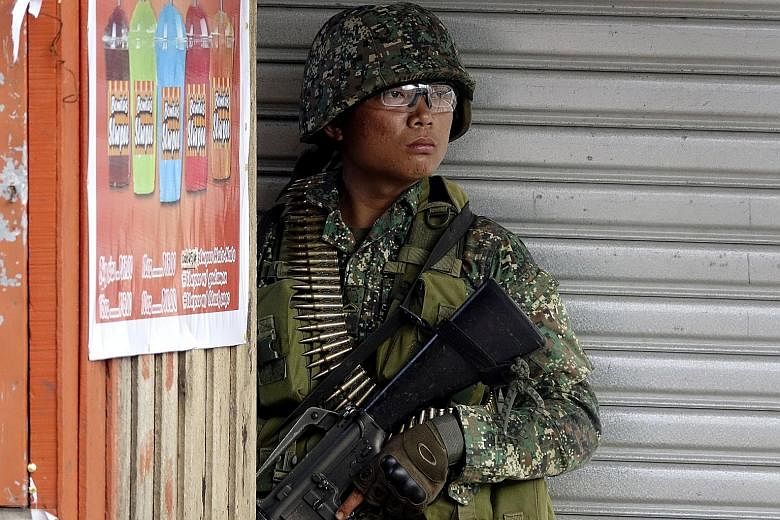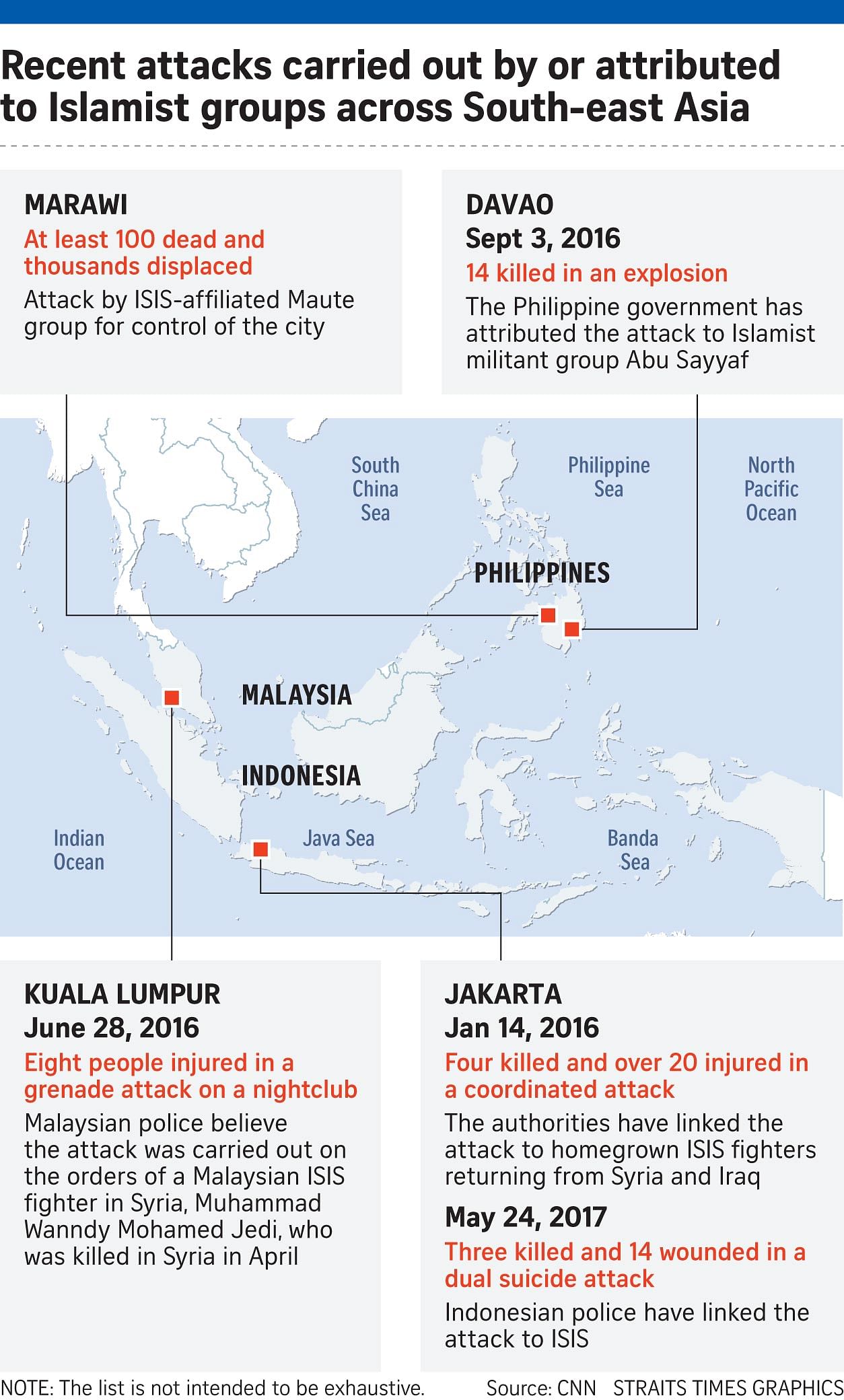In a matter of hours, about 100 militants succeeded in bringing Marawi, a poor, densely populated Muslim city of 200,000 people, to its knees.
The city, a repository of Muslim culture and tradition some 814km south of the capital Manila, is now a "ghost town", with 90 per cent of its population having fled for safe havens far from its borders.
The view from a tall building at a safe zone near where the military has pitched camp shows houses and buildings with few signs of life.
But overhead, the whirring of the blades of helicopters can be heard. In bursts, these warbirds release rockets, and then black smoke billows from an enclave far away.
It has been like this since last Tuesday, when militants belonging to the Maute group began seizing large parts of the city and then staking their claim with the black flag of their sought-after benefactor, the Islamic State in Iraq and Syria (ISIS).
They had risen up to protect an ISIS chieftain and to show the world just how much destruction a handful of men can wreak.
-
THE BATTLE FOR MARAWI
-
Clashes between the Philippine military and the Maute rebels erupted a week ago in Marawi City, sending civilians fleeing for their lives. Here is a timeline of how the ongoing battle has unfolded.
-
MAY 23
The military botches an afternoon raid to capture Isnilon Hapilon, point man for ISIS (Islamic State in Iraq and Syria) in South-east Asia. Fighting with Maute rebels ensues in Marawi. By 7pm, rebels reportedly occupy a hospital, jail and police station in Marawi City. Buildings are torched. Three soldiers die and 12 others are wounded. Philippine President Rodrigo Duterte, who is in Russia, places Mindanao Island under martial law.
-
MAY 24
Thousands of residents begin fleeing Marawi, a city of 200,000. Six civilians are taken hostage by the militants. The military clears the occupied hospital, freeing 78 civilians. Two jailbreaks by the militants release 107 inmates into the city. Mr Duterte arrives in Manila. Thirteen militants and seven security personnel have been killed and 33 troops wounded since the battle began. ISIS claims responsibility for the rampage.
-
MAY 25
The military deploys two helicopters with machine guns to flush out rebels still holed up in buildings, and regain control of a bridge. The death toll climbs, with 11 soldiers, two policemen and 31 militants killed. The Maute take more than a dozen Christians hostage.
-
MAY 26
Foreign fighters from Malaysia, Indonesia and Singapore are reportedly involved in what the Philippine government calls an ISIS "invasion". The death toll hits 46: 15 security personnel and 31 militants.
-
MAY 27
The military ramps up bombing as helicopters fire guided rockets at militant positions in a bid to end the siege quickly.
-
MAY 28
Bodies of eight executed civilians are found dumped outside the city. Reports emerge that some 2,000 civilians are still trapped in the city. The death toll soars: At least 61 militants, 15 security personnel and nine civilians have been killed.
-
MAY 29
More rockets are unleashed by the military, which says it is close to retaking Marawi. At least 100 people have been killed: 61 militants, 20 members of the security forces and 19 civilians.
SOURCES: REUTERS, AGENCE FRANCE-PRESSE
The militants set up checkpoints along Marawi's roads and bridges, attacked a city jail and freed about 100 prisoners to augment their numbers, and briefly occupied a hospital and large parts of a sprawling university.
As they retreated, they began torching houses and churches, and taking hostages.
Seven days on, the military's spokesman declared that "the end is almost there", as the insurgents are routed and pinned down in nine of Marawi's 100 districts.
As helicopters unleash rockets from the sky and special forces battle for each door, house and building on the ground, the scale of the mayhem is becoming clearer.
On Sunday, the bodies of eight men who worked at a bakery were found in a ditch just outside the city limit. They all had a bullet in the head, and some had their hands tied behind their backs.
A woman who witnessed the killing said the men were fleeing the fighting when a group of militants chanced upon them.
They were told to recite verses from the Quran. When they could not, they were executed. A piece of paper with "traitors" written on it was left on one of the bodies.
"They did not kill me because I was able to recite a Muslim prayer. The others were not so lucky," the woman said.
Another 11 civilians have been confirmed killed, among them a child and three women, whose decomposing bodies were discovered near a university.
A reporter from Al-Jazeera who has been in Marawi for days wrote on Facebook: "We saw a corpse. He looked like a combatant, possibly dead for five days. He was rotting. His lower body is gone, eaten by dogs."
Yesterday, 14 men who worked at a school turned up at a military camp, having escaped from the militants who beheaded a fellow hostage.
They told reporters that they were making their way out of the city when they were stopped by about 20 gunmen. They were held inside a building, where they were forced to make a video begging the military to halt the air strikes or else their captors would start beheading them.
They managed to escape when the military began shelling the building. But they said there was another group of hostages being held on another floor. One of them was a priest.
Some 2,000 more are trapped in their homes in districts where the militants are still roaming freely. With their phones, they are begging for deliverance. They ask for food, water, and a halt to the bombings.
With the remaining charge on her phone, a woman sent a message to a hotline set up by emergency responders: "They are already inside our home."
In Iligan City, 40km away from Marawi, evacuation centres are overflowing.
There, everyone is hoping that the fighting will end and they can go back to their homes and resume lives abruptly disrupted by a war over religion.
But they know that is unlikely to happen any time soon.
The militants behind Marawi siege
MAUTE
The militants mostly belong to the Maute group, which the government estimates has about 260 armed followers.
It is one of a number of hardline groups that split from the nation's biggest Muslim rebel organisation after it was angered over a planned peace accord.
The Maute gunmen were protecting Isnilon Hapilon, the leader of Abu Sayyaf, the kidnap-for-ransom gang that is believed to have only a few hundred gunmen but has been blamed for the nation's worst terrorist attacks.
The Maute and Hapilon's faction of Abu Sayyaf have pledged allegiance to the Islamic State in Iraq and Syria (ISIS) and want to establish a caliphate for it in southern Philippines, according to Philippine President Rodrigo Duterte and security analysts.
ISNILON HAPILON
Hapilon, 51, an Arabic-speaking preacher with an engineering degree from the Philippines' top university, is one of the world's most wanted terrorists.
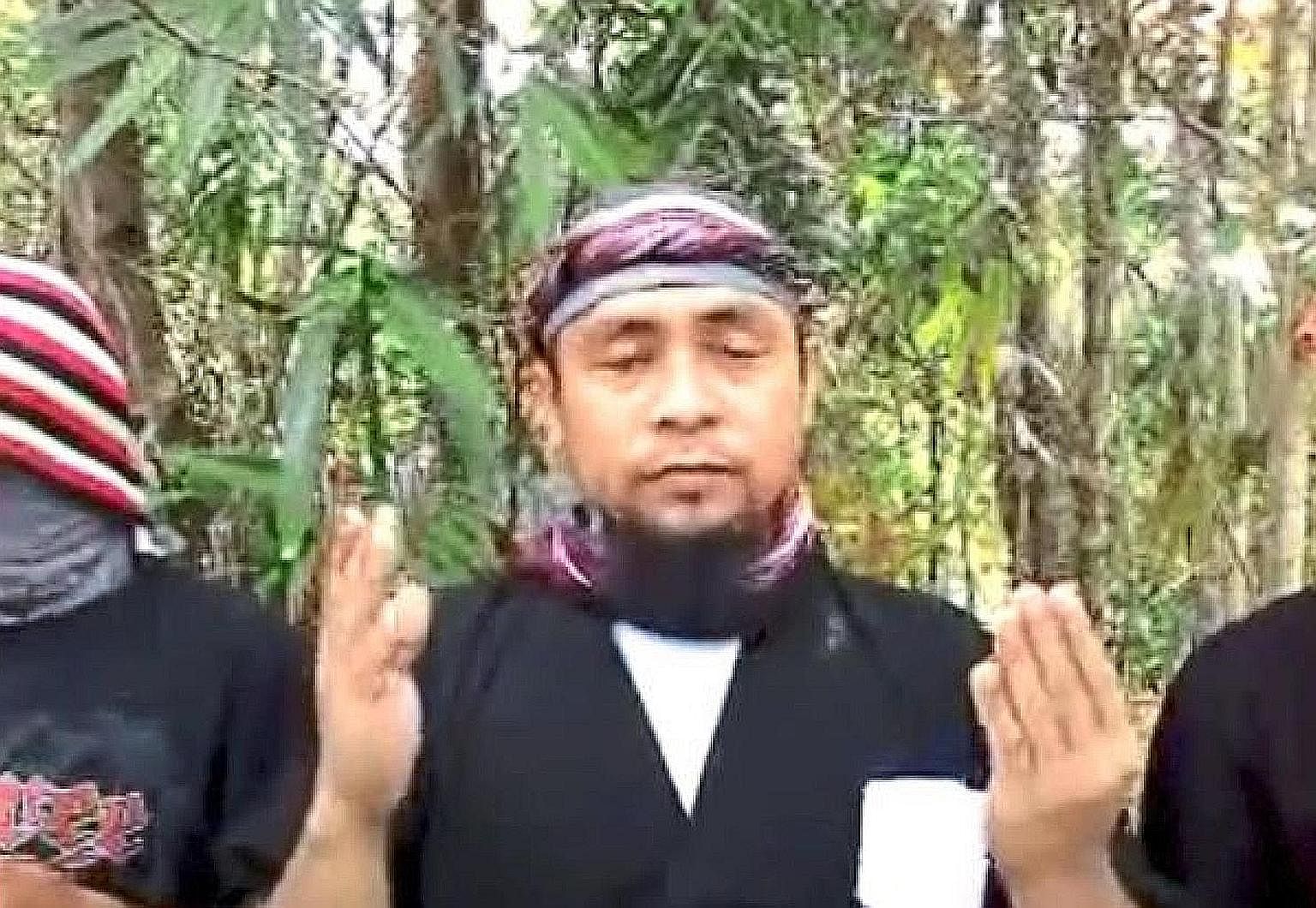
Hundreds of people have died and millions have been spent in the hunt for the Abu Sayyaf chieftain designated by ISIS as its top man in South-east Asia last year.
But he remains elusive.
He gained notoriety in 2001 when he took part in the kidnapping of 20 hostages from a resort in Palawan province. He rose up the ranks of Abu Sayyaf to become its second in command.
The United States is offering a US$5 million (S$6.9 million) reward for his capture.
SINGAPOREAN LINK?
The Philippine military's Brigadier-General Restituto Padilla told reporters last Friday that Singaporeans are involved in the days-long clashes in Mindanao.
Singapore's Ministry of Home Affairs (MHA) later said in a statement that a Singaporean named Muhamad Ali Abdul Rahiman, alias Muawiya, has been in southern Philippines since the 1990s and is known to be implicated in terrorism-related activities there.
But the MHA said there is no information as to whether he is involved in the armed insurgency in Marawi.
